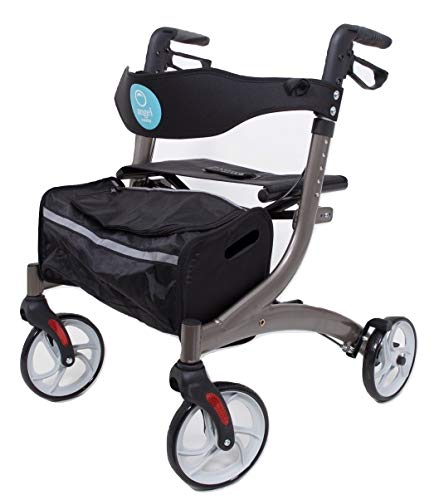Rollator Seat Enhances Comfort and Convenience
 A rollator seat can be a wonderful spot to relax on walks or outings. These ingenious mobility aids let seniors continue enjoying the scenery and the events they enjoy without having to worry about discomfort or fatigue.
A rollator seat can be a wonderful spot to relax on walks or outings. These ingenious mobility aids let seniors continue enjoying the scenery and the events they enjoy without having to worry about discomfort or fatigue.
To find the ideal rollator for your needs Begin by determining the appropriate handle height. Take a measurement of the distance from your hips to the floor and add an inch or two.
Comfortable Seating
A majority of rollators come with an inbuilt chair that lets users rest or take a break walking. They can be folded up when not in use and are usually cushioned for comfort. Some come with storage options, like bags and baskets to store personal items, groceries or medical equipment.
When choosing the right rollator with a seating option, take into consideration the user's preferences and needs. The first thing to consider is height of the seat to floor, which needs to be compatible with the measurements of the user. For this measurement the user must stand in their regular shoes, with their elbows slightly bent and their arms to their sides. Then, record the distance from the floor to the center of their wrist. This is the handle height.
Make sure that the seat's depth is sufficient to support their thighs while they are sitting in a straight position. Select a seat that has a backrest to support the entire length of your spine. This design distributes the weight evenly across the seat, reducing the strain on muscles and joints.
Curved backrests are also important to ensure adequate spinal support. The lower five lumbar spines create the concave curvature back's small and attach to the sacrum (a broad triangular shaped bone at the base the pelvis). The twelve thoracic vertebrae, which form a convex curvature in the middle of your back, are located above these. Finally, the seven cervical vertebrae comprise the neck.
While a curved backrest can be an extra expense, it is well worth the investment to improve both comfort and function. The additional support offered by a curved chair may help users maintain an ideal posture while sitting. This could reduce the stress on their back or shoulders.
When shopping for a rollator, take into consideration the frame width and seat size to make sure it can pass through commonly used doorways and passageways. It is important to check for available replacement parts in the event that the device is damaged beyond repair. The manufacturer will typically provide the links on their site to purchase these parts.
Adjustable Seat-to-Floor Height
The correct adjustment of the seat's height is essential for promoting stability and reducing fatigue in the thighs, and promoting good posture. The height of the seat is measured from the back to the popliteal fossa or the kneecap of the person. A client may require a lower seat-to-floor height to ensure a proper heel strike when self-propelling. This could be due to postural reasons, such as maintaining the hips in a neutral position when transferring or to provide an increased thigh-to-trunk angle to aid in postural correction.
Rollator users who require a higher seat-to-floor height should think about a model with a bariatric design that has an extra seating area and weight capacity of up to 500 pounds. These models are typically larger than standard four-3 wheel rollator with seat rollators and have a reinforced frame with high-quality, large wheels to accommodate heavier user weight.
Seating is also crucial. Padded seats are more comfortable and more comfortable than unpadded plastic which can become uncomfortable and hot after prolonged use. The padded and contoured seating is usually more expensive than seating that is not padded. However, the added price can be worth it in terms of comfort and durability.
If a person's range of motion is limited, a padded seat or a curved chair that lifts the person to a more upright position is better suitable. This can help reduce the strain on their hips as well as knees while walking, and permit them to engage in MRADLs without needing additional caregiver assistance.
It is recommended to test the height of the rollator in a shop or at home before making an purchase. Ask the customer to Sit & Roll: Rollator Walker with Seat in the chair with their feet flat on the ground without shoes. Keep their elbows slightly bent and their arms on the sides. To determine the ideal handle height for you, measure from the wrist's center to the ground.
It is crucial that the handle height and seat height are aligned perfectly for optimal performance. If the seat and handle are adjusted to the ideal height, the user is able to rest more comfortably. This eases the stress on muscles and joints. It's also helpful to take into consideration the size of frequently-used entrances and passageways in determining whether a certain model is able to overcome those obstructions.
Storage Baskets or Pouches
Rollator seats are equipped with storage baskets and pouches that allow users to carry their personal belongings, or medical equipment on longer excursions. These items are usually placed beneath the seat and secured with a strap or flap that can be shut and opened. Some models feature a mesh or wire basket, while others have a tray that holds the bag securely. Some tray models can also be removed for cleaning purposes, which helps keep the interior tidy.
Many people like to use accessories for their rollators to improve its functionality and user-friendliness. For example the attachment for a cup holder will eliminate the need to hold a beverage using hands, while food tray attachments provide the convenience of storing food items and snacks for when you're on the go. There are many manufacturers that offer different attachments for specific models.
The Hugo Mobility Explore is a model that we liked, with a spacious under-seat storage bag for accessories and a handy folding mechanism. It's one of the tiniest models we evaluated, and its massive, all-terrain 8-inch wheels make it a great choice for outdoor use, too. Panelists loved that the rollator can be folded down to a compact size for easy transportation in a car or on public transportation.
When purchasing a rollator, buyers should take into consideration the frame's material and weight capacity and the color. Aluminum frames are lightweight rollators with seat and offer stability and aplomb. Steel frames are stronger for users who weigh more than 250 pounds. Certain models also have bariatric or heavy-duty rollators which have a higher capacity for weight and are larger than standard models to accommodate larger users. Some also have a padded seat that can help reduce pressure points and ease the pain caused by conditions like sciatica or arthritis.
Accessories
The accessories for rollators can be customized to meet the requirements of each user. Soft cushions for seats, adjustable heights from the floor to the seat and storage pouches or baskets are just a few options that can increase comfort and convenience.
Many of these accessories help to reduce the stress on muscles and joint and joint mobility, thus promoting mobility. The addition of padding can make the seating more comfortable for those who sit often or are recovering after surgery or an injury. Padded arm rests will also help reduce discomfort when walking or sitting for long durations. Other popular additions include a cup holder or walker tray that can be used to carry personal belongings as well as snacks and medical equipment without needing to reach over the handles or use a hands-free option such as a bag for toting.
Some rollator models permit the user to add a cushioned seat that folds up to allow you to easily switch from walking to sitting. Plastic seats that are not padded are easier to clean and give a feeling of stability. While padded seats may be more comfortable, they may also be more durable. No matter what type of seat, the most important consideration is to select a seat that is safe for the individual's needs and lifestyle. For instance, it's essential to ensure that the brakes are turned on and activated prior to sitting down, as failure to do so could result in injuries or falls. A caregiver for seniors at home can promote the safety of the rollator by reminding patient that the parking brake should be activated prior to transferring from a standing position to a sitting position.
The wheels you choose can be a major element in how well a rollator operates. Smaller wheel sizes, typically 6" or 7" in diameter, provide an even more compact turning radius, which is beneficial for moving around inside spaces and around furniture. The larger wheel sizes can be as large as 10" in diameter, and provide smoother rides on uneven outdoor terrain. A rollator that has locking wheels can also provide extra security and prevent the brakes from accidentally being removed in the course of use.
